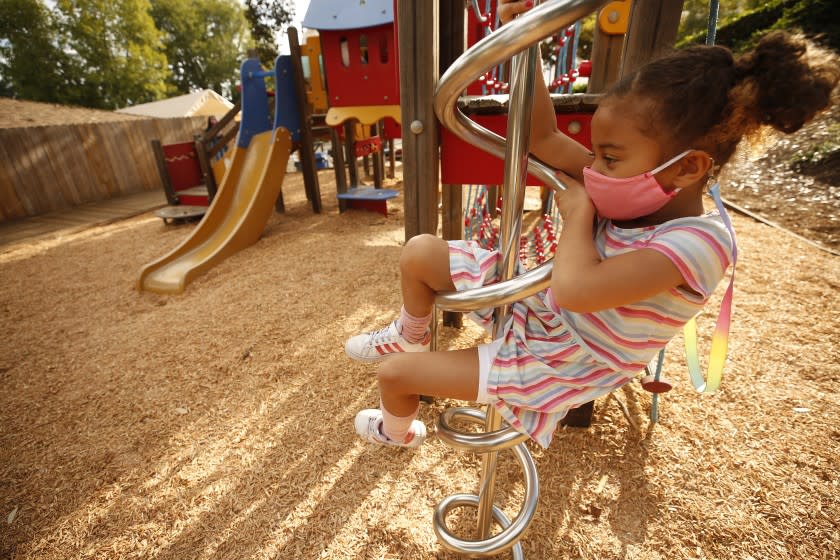Op-Ed: Why we should let children go maskless outdoors this summer

We are living in a modern dystopia when, in the name of science, adults enjoy life unmasked while young children are masked; adults freely go to restaurants and gyms while children have attended school mainly by remote learning. The U.S. pandemic policies have firmly placed us in this position.
The Centers for Disease Control and Prevention released updated guidance for youth camps in late May that used vague wording that could be read as recommending continued outdoor masking of children. “People who are not fully vaccinated,” it said, “are encouraged to wear a mask in crowded outdoor settings or during activities that involve sustained close contact with other people who are not fully vaccinated.” Most group camp activities will require “sustained close contact.”
Since the CDC has yet to specifically address masking of children in other settings, gaps in the guidance have led to confusion. Some are using the camp guidance to extrapolate to other settings. As of now, the CDC recommends that unvaccinated people should wear masks anywhere they will be around other people.
As pediatricians, the two questions we must ask are “what is the scientific evidence to support the outdoor masking recommendation for children?” and “how will the endpoint for the masking of American children be determined?”
To answer the first question, the risk of outdoor transmission to and from children must be assessed. Many studies have shown that few infections are transmitted outdoors, regardless of age. A conservative estimate published in February in the Journal of Infectious Diseases found that the odds of indoor transmission are 18.7 times higher than outdoors.
However, according to current scientific evidence, masks are simply not necessary in outdoor settings. As with many things COVID-related, there is no one definitive study on pediatric outdoor masking. Our opinion is based on the fact that many studies conclude that outdoor transmission is highly unlikely and that children are less likely to transmit the virus than adults.
Coupled with the low rates of community transmission, it no longer makes sense to require children to be masked outdoors, despite being unvaccinated.
Children are regarded as vectors — people who harbor infectious diseases and infect others — for some respiratory and gastrointestinal viruses. But many studies examining the ability of children to spread COVID-19 in household and daycare, school or camp settings have determined that they have not been the primary drivers of transmission. Children are not the main COVID-19 vectors. Adults are.
Children are asking “when can we stop wearing masks?," but we cannot give them a definitive answer because there is not one in sight. An endpoint based on vaccination of children 2-11 years is not acceptable. We don’t know when an approved vaccine will be available for this age group. The key to ending the pandemic is the vaccination of adults. For instance, Israeli COVID-19 rates plummeted after those 16 years old and above were vaccinated.
The United States is an outlier in the international community regarding masking of children. Recent guidance from the CDC advises keeping children as young as 2 masked when they are outdoors, while the World Health Organization recommends not masking children age 5 and under. England has never recommended masking for children younger than 11 and, based on low community transmission, no longer requires secondary students to wear masks at school.
The U.S. should develop metrics that allow our children to go maskless indoors when community rates are low. Influenza can lead to severe illness and hospitalizations in children ages 2 to 11, and the mortality rates in children for influenza and COVID are similar, yet mask mandates surely won’t be imposed every influenza season.
Top public health officials must establish an approach to masking based on the science and pair it with strong messaging that clearly relays children can safely attend school, summer camps and recreational programs — and neither parents nor youngsters need to worry about whether they should be wearing a mask outdoors.
The prolonged school closures of the last year have led to loss of learning milestones, along with a rise in obesity and declining mental health for children and parents. In order to make informed decisions, parents, teachers and pediatricians need evidence-based risk assessments that do not inflate risk of infection, transmission or severity of COVID in children.
It is the responsibility of the CDC to counter fear about COVID with a data-driven approach. Making children wear masks outdoors during physical activity is uncomfortable and may keep them from being physically active, particularly during hot summer months. It is also unnecessary.
Dr. Mayssa Abuali is a pediatric infectious diseases specialist at Einstein Medical Center in Philadelphia. Dr. Amy Beck is an associate professor of pediatrics at UC San Francisco. Also contributing to this article are Dr. Neeti Doshi, assistant professor of pediatrics at UCSF; Dr. Roshni Mathew, clinical associate professor of pediatric infectious disease at Stanford University; and Dr. Shawn Ralston, editor in chief of Hospital Pediatrics.
This story originally appeared in Los Angeles Times.

